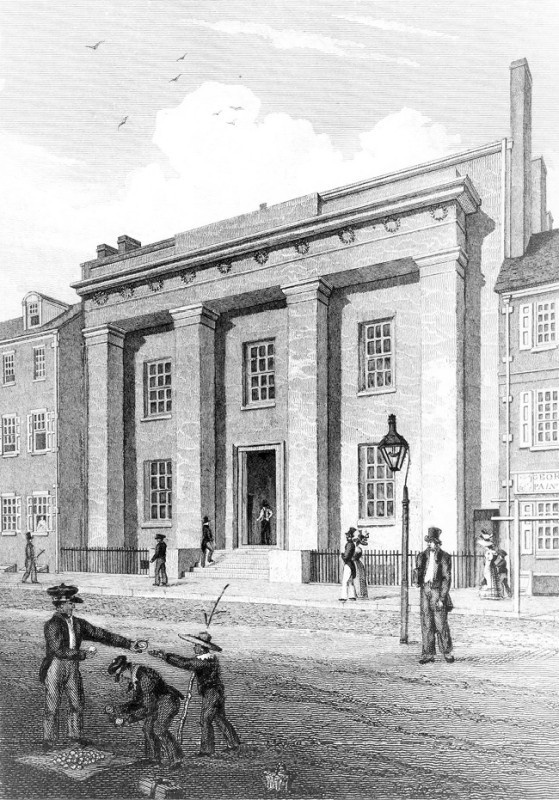
Vintage print depicting the original Franklin Institute building, possibly 1824. Reproduced from Bruce Sinclair, Philadelphia’s Philosopher Mechanics: A History of the Franklin Institute, 1824–1865 (Baltimore, Md.: Johns Hopkins University Press, 1974).

Game pitcher, Abraham Miller, Philadelphia, Pennsylvania, 1840s. Rockingham glazed earthenware. H. 9". Mark, impressed on underside: ABM MILLER. (Private collection; photo, Randl Bye.)
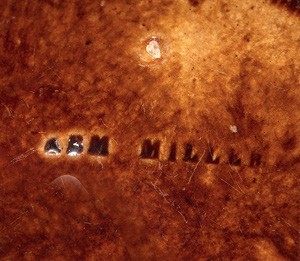
Detail of the pitcher illustrated in fig. 2, showing the mark on the underside.

Log cabin money bank, Thomas Haig Jr., Philadelphia, Pennsylvania, 1850s. Earthenware with flint enamel glaze. H. 4 1/2". Mark, inscribed in script on underside: “Peter Feltey.” (Private collection; photo, Randl Bye.)
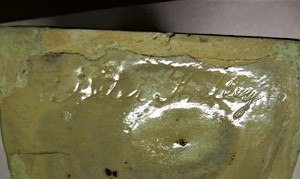
Detail of the bank illustrated in fig. 4, showing the inscription on the underside.
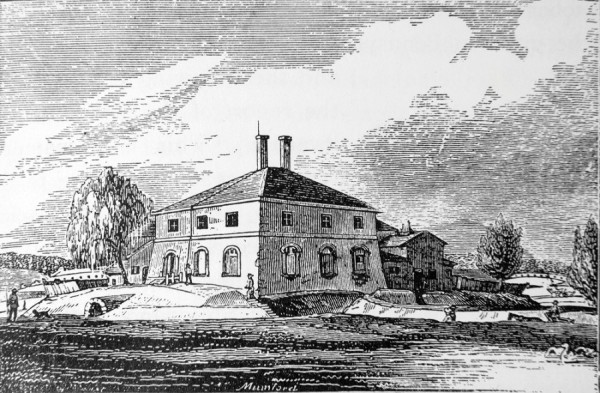
The Old Water-Works, Philadelphia, Used as a China Manufactory in 1825, vintage print depicting Tucker’s china manufactory in Philadelphia, Pennsylvania, 1825. Reproduced from Edwin Atlee Barber, The Pottery and Porcelain of the United States: An Historical Review of American Ceramic Art from the Earliest Times to the Present Day (1893; reprint, New York: Feingold and Lewis, 1976), p. 129.
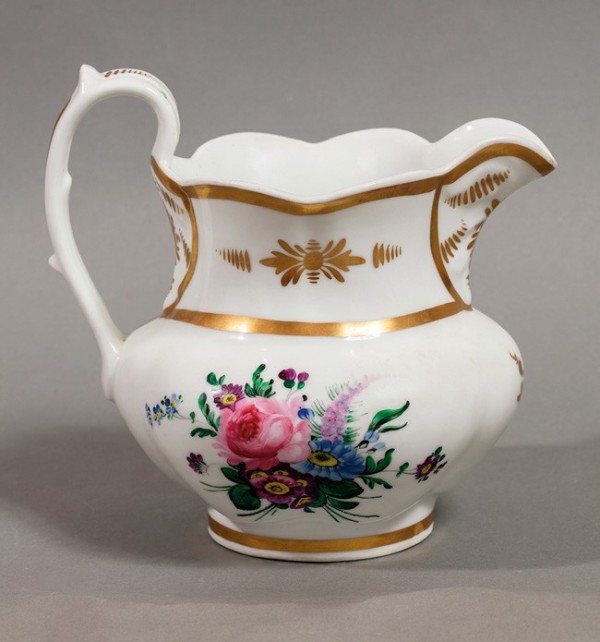
“Grecian pitcher,” Andrew Craig Walker for the William Tucker factory, Philadelphia, Pennsylvania, ca. 1828–1838. Gilt and enameled porcelain with floral design. H. 8". (Private collection; photo, Randl Bye.) The flaring gilt design is typical of Tucker porcelain.
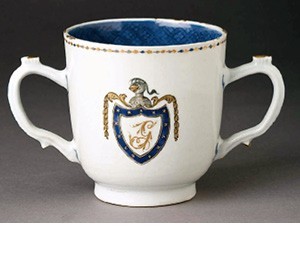
Detail of the pitcher illustrated in fig. 7, showing the incised letters on the underside. According to Barber, an incised “W” either in script or straight lines was used by Andrew Craig Walker, a leading molder at the Tucker factory. Barber added, “It occurs on many of the best pieces.” Barber, Pottery and Porcelain (reprint), Marks of American Potters, p. 17.
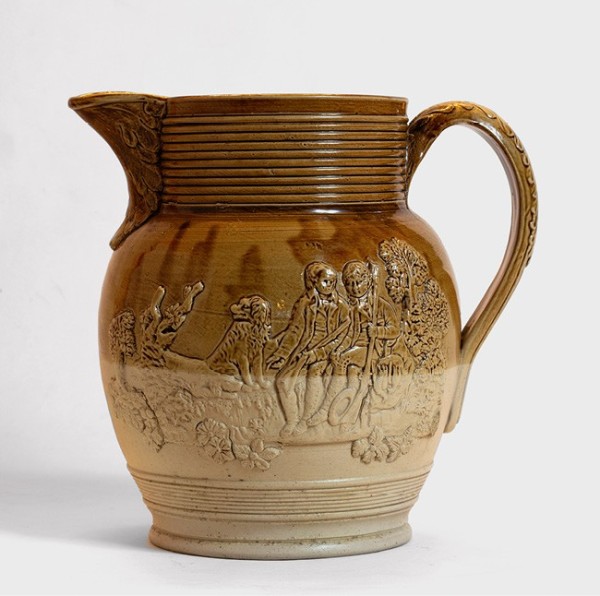
Hunt pitcher, D. & J. Henderson, Jersey City, New Jersey, ca. 1828. Flint stoneware. H. 10 1/2". Mark, impressed on underside: HENDERSON’S STONEWARE / & EARTHENWARE / MANUFACTURER, / JERSEY CITY, N.J. (Private collection; photo, Randl Bye.)

Detail of the pitcher illustrated in fig. 9, showing the impressed mark on the underside. This mark, perhaps the firm’s earliest, was rarely used.

Pitcher with acorn-and-oak-leaf decoration, D. & J. Henderson, Jersey City, New Jersey, ca. 1830. Salt-glazed flint stoneware. H. 8 1/2". Marks, impressed on underside: “D. & J. / Henderson / Jersey City” within two concentric circles; “O” (Private collection; photo, Randl Bye.) The “O” probably relates to the size of this model.

Detail of the pitcher illustrated in fig. 11, showing the impressed mark.

“Grecian pitcher in the Tucker style,” Smith, Fife & Co., Philadelphia, Pennsylvania, ca. 1830. Porcelain with gilt and enameled decoration. H. 7 1/2". (Philadelphia Museum of Art, gift of John Morris, 1893.)
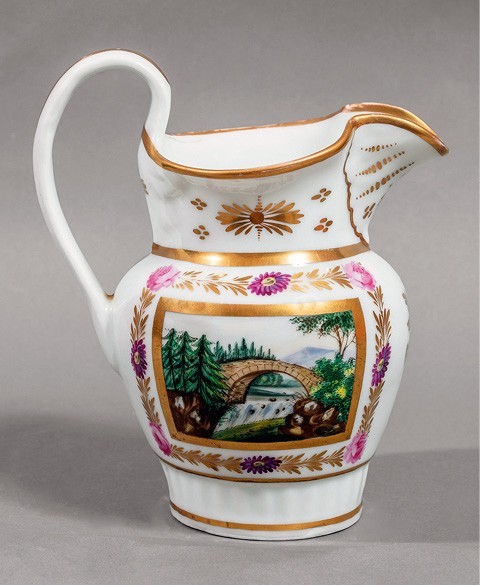
“Vase Shaped Pitcher with Landscape Decoration,” Andrew Craig Walker for the William Tucker factory, Philadelphia, Pennsylvania, ca. 1831–1838. Enameled and gilt porcelain. H. 9". Mark, incised on underside: “W” (composed of two “V”s). (Private collection; photo, Randl Bye.)
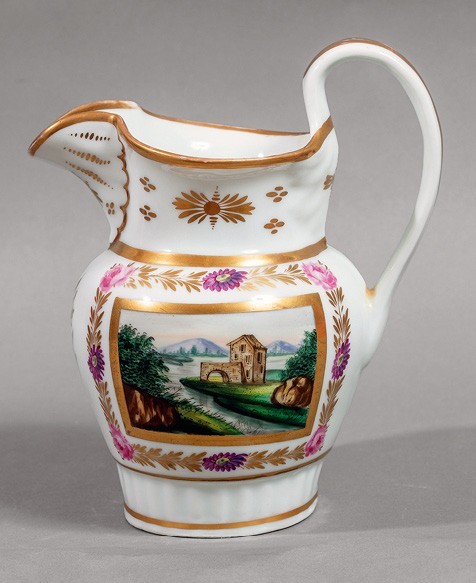
Landscape on the reverse of the pitcher illustrated in fig. 14.

Detail of the pitcher illustrated in fig. 14, showing the two incised “V”s on the underside. According to Barber, this mark was also frequently used by Walker.

“Wall fountain,” American Pottery Company, Jersey City, New Jersey, ca. 1833–1838. Creamware. H. 11". Circular scalloped mark impressed, “AMERICAN POTTERY CO. / JERSEY CITY” (Private collection; photo, Randl Bye.)
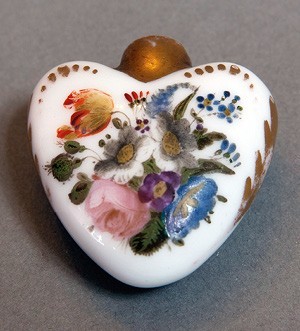
“Heart shaped perfume bottle,” William Tucker factory, Philadelphia, Pennsylvania, 1830–1835. Enameled and gilt porcelain. H. 1 1/2". (Private collection; photo, Randl Bye.)

“Spittoon,” American Pottery Company, Jersey City, New Jersey, ca. 1842. Glazed earthenware. H. 3", diam. 8". (Collection of the Franklin Institute.)

Tea set, Daniel Greatbatch for the American Pottery Company, Jersey City, New Jersey, ca. 1840. Creamware. Covered sugar dish H. 3 1/2"; teapot H. 3 1/2"; creamer H. 3". Circular marks, impressed: AMERICAN POTTERY, JERSEY CITY (Private collection; photo, Randl Bye.)
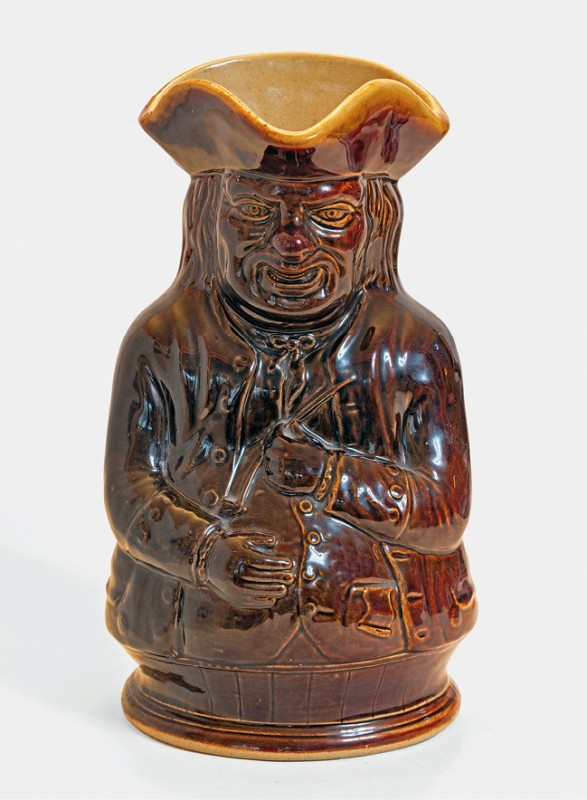
“Toby jug,” Daniel Greatbatch for the American Pottery Company, Jersey City, New Jersey, ca. 1840–1845. Rockingham glazed earthenware. H. 10 1/2". Circular mark, impressed:AMERICAN POTTERY, JERSEY CITY, NJ (Private collection; photo, Randl Bye.)
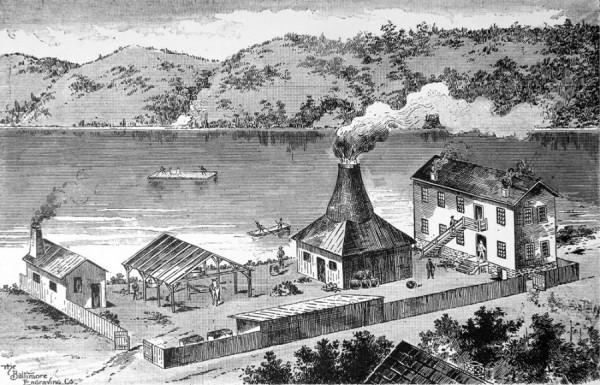
The Old Bennett Pottery, East Liverpool, O., The Baltimore Engraving Co., ca. 1900. Vintage print depicting the Bennett Pottery in East Liverpool, Ohio. Reproduced from Barber, Pottery and Porcelain of the United States, p. 193.
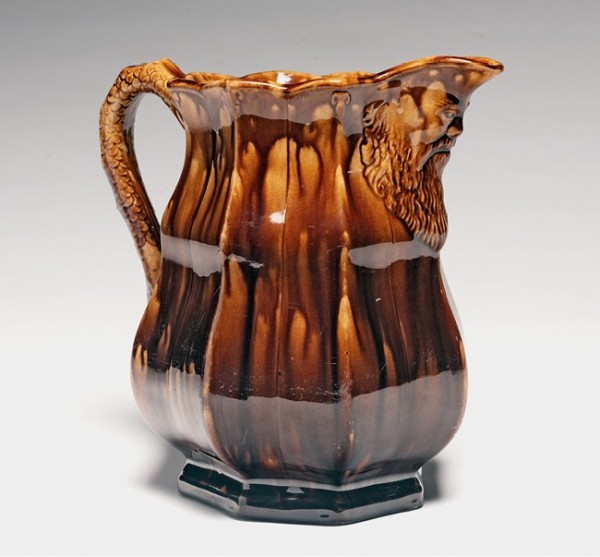
“Druid Spout Pitcher with Snake Handle,” E. & W. Bennett Pottery, Baltimore, Maryland, ca. 1848. Earthenware with Rockingham glaze. H. 9". Mark, impressed on underside: E & W BENNETT, / CANTON AVENUE, / BALTIMORE. (Lora Robbins Gallery of Design from Nature, University of Richmond Museums, gift of Emma and Jay Lewis; photo, Meg Eastman.)
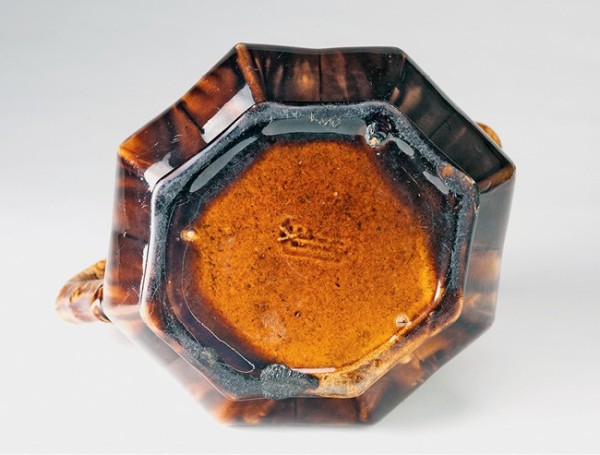
Detail of the pitcher illustrated in fig. 23, showing the mark.
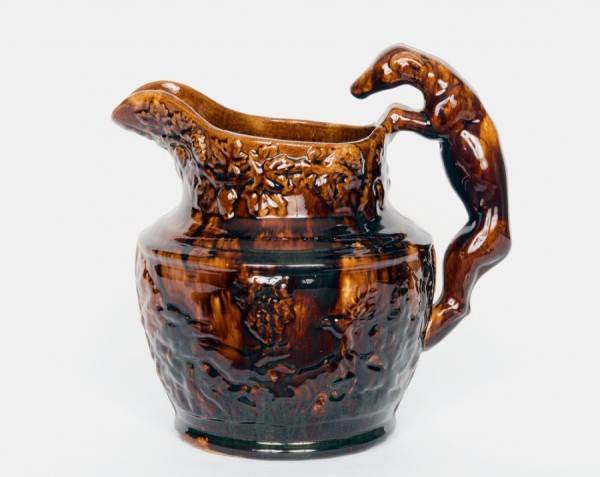
“Hunt Pitcher,” Harker Taylor, East Liverpool, Ohio, ca. 1846–1852. Earthenware with Rockingham glaze. H. 10". (Philadelphia Museum of Art, gift of Jay and Emma Lewis, 2008.)
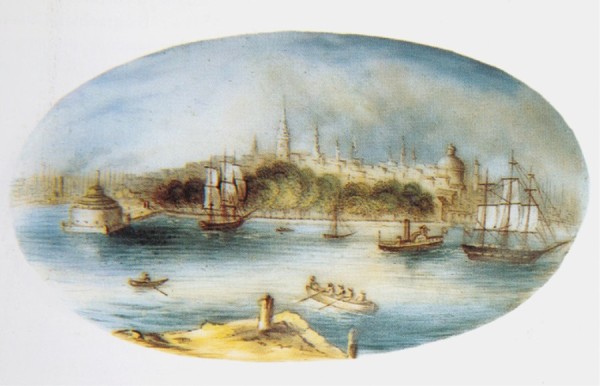
“Doorplate with View of New York City,” Elijah Tatler for Charles Cartlidge & Company, Greenpoint Brooklyn, New York, 1848–1850. Enameled porcelain. H. 1 1/2", W. 3".
(Private collection.)

Ralph Bagnall Beech (active 1845–1857), Philadelphia, Pennsylvania, ca. 1851. Daguerreotype. 4 x 3 1/2 x 1". (Winterthur Museum, Museum purchase and a gift from Emma and Jay Lewis; photo, Jay Lewis.)
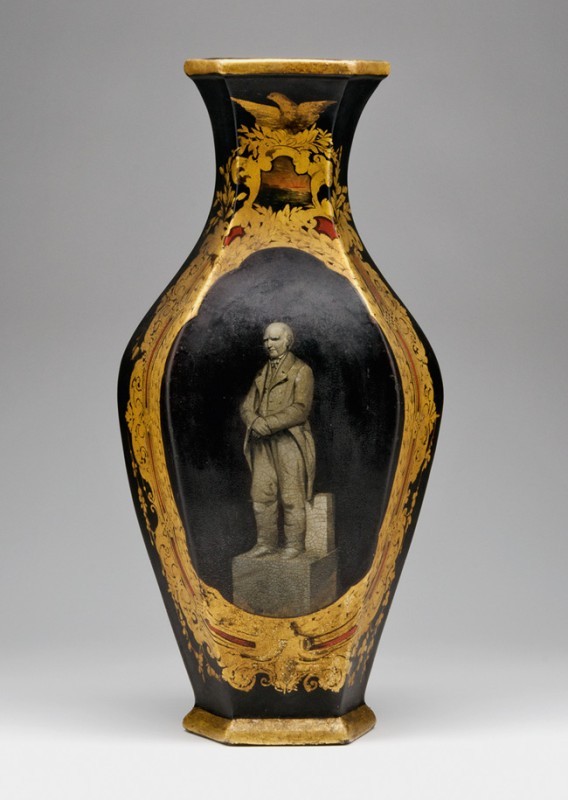
“Japanned Vase with Mother-of-Pearl inlay and full body portrait of Stephen Girard,” William Crombie for Ralph Bagnall Beech, Philadelphia, Pennsylvania, 1851. Porcelain. H. 16". (Philadelphia Museum of Art, gift of John T. Morris, 1902.) Stephen Girard was a wealthy Philadelphia banker and philanthropist.
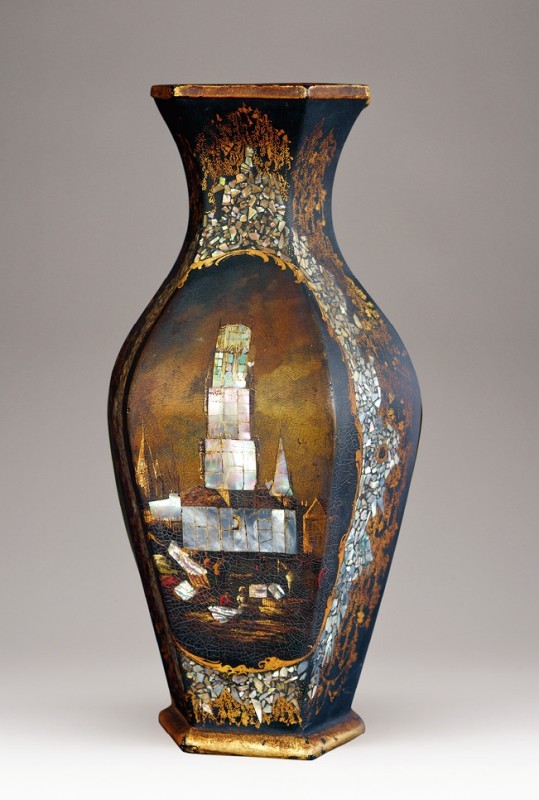
“Japanned Vase with Architectural Landscape and Mother-of-Pearl Inlay,” Ralph Bagnall Beech, Philadelphia, Pennsylvania, 1851. Earthenware. H. 18 1/2". Mark, impressed on underside: RALPH B. BEECH, / PATENT, / JUNE 3, 1851, / KENSINGTON, PA. (Winterthur Museum, Museum purchase and a gift from Emma and Jay Lewis; photo, Jay Lewis.)
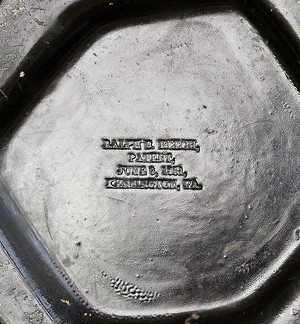
Detail of the vase illustrated in fig. 29, showing the impressed mark.
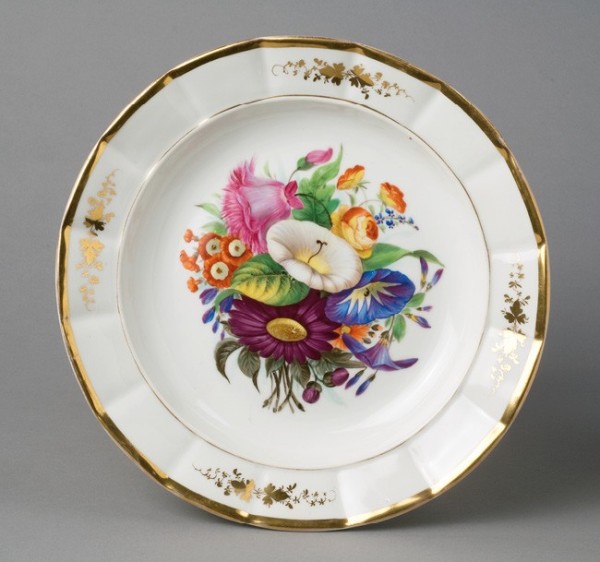
“Floral Cake Plate from a dessert service,” Karlbaum & Schwartz, Philadelphia, Pennsylvania, ca. 1852. Enameled and gilt porcelain. Diam. 9 1/2". Mark, impressed on underside: K + S. (Philadelphia Museum of Art, gift of Mrs. Robert John Hughes, 1939.)
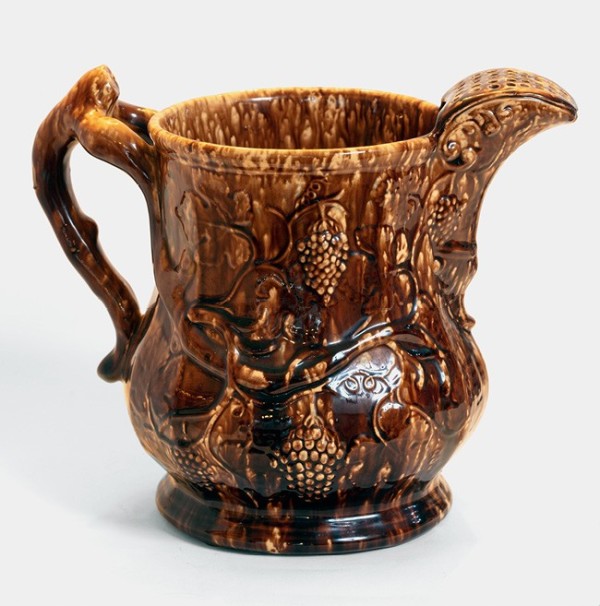
“Grape Ice Pitcher,” Daniel Greatbatch for the Swan Hill Pottery, South Amboy, New Jersey, ca. 1852. Rockingham with flint enamel. H. 9 1/2". Mark, embossed swan mark that indistinctly reads: “Hanks and Fish, Swan Hill Pottery, S. Amboy, N.J.” (Private collection; photo, Randl Bye.)

“Pitcher Depicting Two Young Boys at Play,” American Porcelain Manufacturing Company, Gloucester, New Jersey, ca. 1854. Porcelain. H. 8". Mark, impressed: APMCo. (Courtesy, Brooklyn Museum, the Arthur W. Clement collection.)
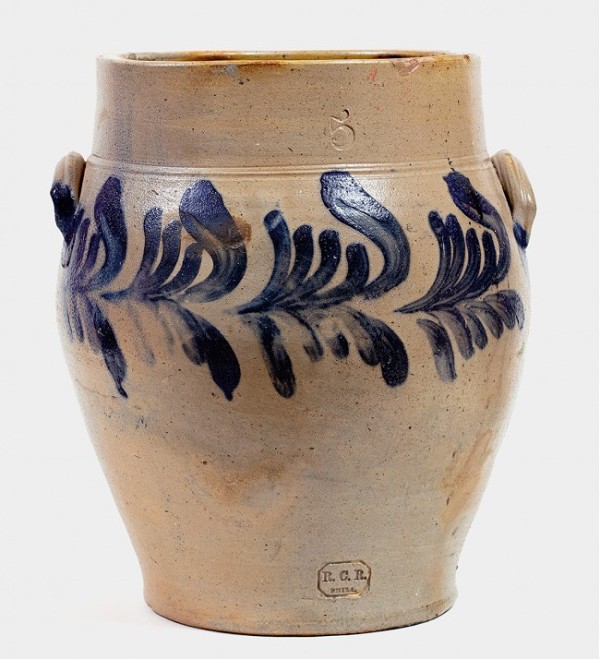
“Five gallon crock,” Richard Clinton Remmey, Philadelphia, Pennsylvania, 1860–1880. Stoneware with cobalt decoration. H. 15 1/2". Marks: incised on neck, “5”; impressed near base, R.C.R. / Phila. (Private collection; photo, Randl Bye.)

Detail of the crock illustrated in fig. 34, showing the impressed mark near the base.
